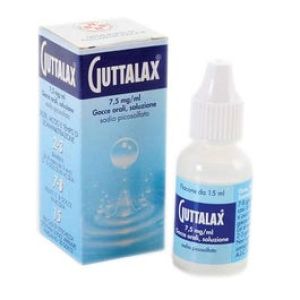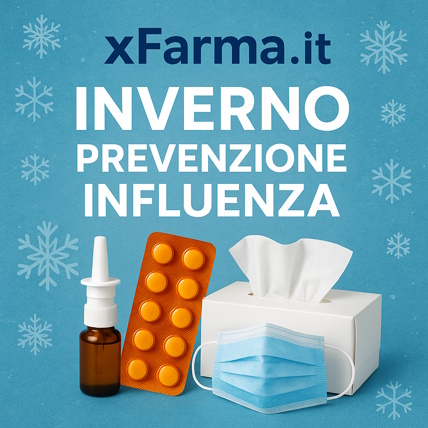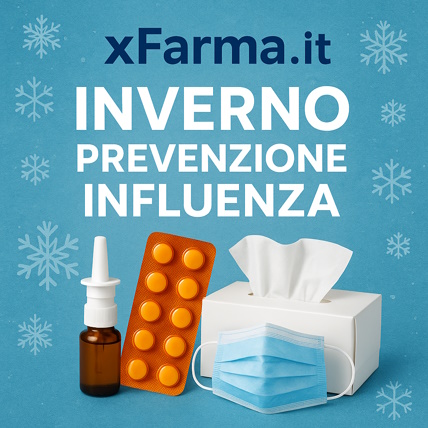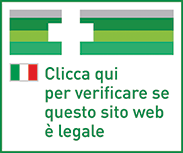Ship in Europe, Find out rates!
Language
Guttalax 7.5 mg/ml Drops 15ml bottle

Regular Price
€10.90
Special Price
€9.14
-16%
Save: €1.76
In stock
Recent lowest price:
€9.14
- box Delivery in Italy in 24/48 and free returns
- star3.000+ positive reviews
- dropboxOver 60,000 products in the catalog
Manufacturer
BOEHRINGER
SKU
020949020
Active principle
SODIO PICOSOLFATO
BEFORE USE CAREFULLY READ ALL THE INFORMATION CONTAINED IN THE PACKAGE LEAFLET This is a SELF-MEDICATION medicine that can be used to treat mild and transient disorders that are easily recognizable and resolvable without seeking medical attention. It can therefore be purchased without a prescription but must be used correctly to ensure its effectiveness and reduce unwanted effects. For more information and advice, contact your pharmacist. Consult your doctor if the disorder does not go away after a short period of treatment. Name of the medicinal product GUTTALAX 7.5 mg / ml oral drops, solution Sodium picosulfate. What is Guttalax is a contact laxative. Why it's used Guttalax is used for the short-term treatment of occasional constipation. When not to be used Guttalax is contraindicated in patients with: hypersensitivity to the active substance (sodium picosulfate) or to any of the excipients, paralytic ileus or intestinal or biliary obstruction or stenosis, severe acute painful and / or febrile abdominal conditions (such as appendicitis) associated with nausea and vomiting,? severe dehydration, rare hereditary conditions of incompatibility with any of the excipients (see "It is important to know that") the use of the medicinal product is contraindicated, nausea or vomiting, acute inflammation of the gastrointestinal tract, rectal bleeding of unknown origin, gallstones, liver failure, pregnancy and breastfeeding (see "What to do during pregnancy and breastfeeding"). Do not administer to children under 3 years of age. Precautions for use In children between 3 and 12 years of age, the medicine can only be used after consulting your doctor. The treatment of chronic or recurrent constipation always requires the intervention of the doctor for the diagnosis, the prescription of drugs and the surveillance during the course of therapy. Consult your doctor when the need for the laxative derives from a sudden change in previous bowel habits (frequency and characteristics of bowel movements) lasting more than two weeks or when the use of the laxative fails to produce effects. It is also advisable for elderly people or those in poor health to consult their doctor before using the medicine. Like other laxatives, Guttalax should not be taken on a daily basis for extended periods of time. If laxative use is required every day, the cause of constipation should be identified. Which medicines or foods can change the effect of the medicine Tell your doctor or pharmacist if you have recently taken any other medicines, even those without a prescription. Laxatives can reduce the time spent in the intestine and therefore the absorption of other drugs administered simultaneously orally. Therefore, avoid ingesting laxatives and other drugs at the same time: after taking a medicine, leave an interval of at least 2 hours before taking the laxative. Milk or antacids can change the effect of the medicine; leave an interval of at least 1 hour before taking the laxative. Continued use of Guttalax may increase patient response to oral anticoagulants and change glucose tolerance. Concomitant use of diuretics or adrenocorticosteroids and excessive doses of Guttalax may lead to an increased risk of electrolyte imbalance. This imbalance, in turn, can lead to an increase in sensitivity to cardiac glycosides. Concomitant administration of antibiotics may reduce the laxative effect of Guttalax. It is important to know that Like all laxatives, Guttalax should not be taken continuously every day or for long periods of time without investigating the cause of the constipation. Prolonged and excessive use can lead to diarrhea, electrolyte imbalance and hypokalemia. The abuse of laxatives (frequent or prolonged use or with excessive doses) can cause persistent diarrhea with consequent loss of water, mineral salts (especially potassium) and other essential nutritional factors. In severe cases, the onset of dehydration or hypokalemia is possible, which can lead to cardiac or neuromuscular dysfunctions, especially in the case of simultaneous treatment with cardiac glucosides, diuretics or corticosteroids. The abuse of laxatives, especially contact laxatives (stimulant laxatives), can cause addiction (and, therefore, the possible need to gradually increase the dosage), chronic constipation and loss of normal intestinal functions (intestinal atony) Health education notes Before everything must be kept in mind that, in most cases, a balanced diet rich in water and fiber (bran, vegetables and fruit) can permanently solve the problem of constipation. Many people think they are suffering from constipation if they cannot evacuate every day. This is a misconception as this situation is completely normal for a large number of individuals. Consider, instead, that constipation occurs when the bowel movements are reduced compared to one's personal habits and are associated with the emission of hard stools. If episodes of constipation occur repeatedly, a doctor should be consulted. 1 ml (15 drops) of solution contains 0.45 g of sorbitol, equivalent to 0.6 g of sorbitol for taking the maximum recommended daily dose, in the treatment of adults. Patients with rare hereditary conditions of fructose intolerance should not take this medicine. When it can only be used after consulting your doctor Pregnancy and breastfeeding (see "What to do during pregnancy and breastfeeding"). Pediatrics (see "Precautions for use"). It is also advisable to consult your doctor in cases of repeated episodes of constipation (more than three to four per month). What to do during pregnancy and breastfeeding Ask your doctor or pharmacist for advice before taking any medicine. Consult your doctor if you suspect pregnancy or wish to plan a maternity leave. Pregnancy There are no adequate and well-controlled studies on the use of the drug in pregnancy. Long experience has shown no evidence of unwanted or harmful effects during pregnancy. Although no toxic effects have ever been reported during pregnancy, the medicine should only be used in case of need, under the direct supervision of the doctor, after evaluating the expected benefit to the mother in relation to the possible risk to the fetus. Breastfeeding Clinical data show that the active fraction of sodium picosulfate and its glucuronic derivatives are not excreted, in determinable quantities, in breast milk. However, the medicine should only be used in case of need, under the direct supervision of the doctor, after evaluating the expected benefit to the mother in relation to the possible risk to the infant. Fertility Studies to evaluate the effects on human fertility have not been conducted. Non-clinical studies revealed no effect on fertility. Effects on ability to drive and use machines As specific studies have not been performed, there are no known inhibitory effects of Guttalax that would affect the ability to drive and use machines. However, patients should be advised that dizziness and / or syncope may occur due to the vasovagal response (resulting from, for example, abdominal spasm). If patients experience abdominal spasm they should avoid potentially hazardous activities such as driving or operating machinery. How to use this medicine How much Adults In adults it is recommended to start with 7-8 drops in water per day and to decrease if the effect is excessive or to increase if the laxative effect is not achieved. In cases of stubborn constipation, up to 15-20 drops in water can be reached. Use in children and adolescents In children (over 3 years): 2-3 drops in water per day. Warning: do not exceed the indicated doses without medical advice. It is advisable to initially use the minimum doses provided. The correct dose is the minimum sufficient to produce easy evacuation of soft stools. When necessary, the dose can then be increased, but without ever exceeding the maximum indicated. When and for how long The drops should preferably be taken in the evening to evacuate the next morning. Laxatives should be used as infrequently as possible and for no more than seven days. Use for longer periods of time requires a doctor's prescription after adequate evaluation of the individual case. Consult your doctor if the disorder occurs repeatedly or if you have noticed any recent changes in its characteristics. How to ingest together with an adequate amount of water. A diet rich in liquids favors the effect of the medicine. What to do if you have taken too much medicine Signs and symptoms After taking high doses of the medicine, the following may occur: watery stools (diarrhea), abdominal cramps and a significant loss of fluids, potassium and other electrolytes. Cases of colonic mucosal ischaemia have been reported with doses of Guttalax considerably higher than the recommended dosage for the treatment of occasional constipation. Overdose of laxatives is known to cause chronic diarrhea, abdominal pain, hypokalemia, secondary aldosteronism and kidney stones. In association with chronic laxative abuse, renal tubular injury, metabolic alkalosis and muscle weakness secondary to hypokalaemia have also been described. See also the information in the "It's important to know" section about laxative abuse. Treatment If action is taken shortly after ingestion of Guttalax, absorption can be reduced or avoided by induction of vomiting or gastric lavage. Leaking fluids and electrolytes must be replaced. This is particularly important in the elderly and young people. The administration of spasmolytics may be useful. In case of accidental ingestion / intake of an excessive dose of Guttalax, notify your doctor immediately or go to the nearest hospital. If you have any questions about the use of Guttalax, ask your doctor or pharmacist. Side Effects Like all medicines, Guttalax can cause side effects, although not everybody gets them. Adverse reactions are listed below by system organ class and frequency, according to the following categories: Very common> 1/10 Common> 1/100, <1/10 Uncommon> 1 / 1,000, <1/100 Rare > 1 / 10,000, <1 / 1,000 Very rare <1 / 10,000 Not known frequency cannot be estimated from the available data. Immune system disorders: Not known *: hypersensitivity. Nervous system disorders: Uncommon: dizziness. Not known *: syncope. The phenomena of dizziness and syncope that occur after the intake of sodium picosulfate appear to be attributable to a vasovagal response (resulting, for example, from abdominal pain or stool evacuation). Gastrointestinal disorders: Very common: diarrhea. Common: abdominal cramps, abdominal pain and abdominal discomfort. Uncommon: vomiting, nausea Occasionally: isolated cramping pains or abdominal colic, more frequent in cases of severe constipation. Skin and subcutaneous tissue disorders Not known *: skin reactions such as angioedema, rash on drug intake, rash, pruritus. * These adverse reactions have been observed in post-marketing experience. 95% likely, the frequency category is not greater than uncommon, but it could be lower. A precise frequency estimate is not possible as these adverse reactions did not occur in 1020 patients in clinical trials. Compliance with the instructions contained in the package leaflet reduces the risk of undesirable effects. These side effects are usually transient. However, when they do occur, it is advisable to consult your doctor or pharmacist. "Reporting of side effects" If you get any side effects, including any possible side effects not listed in this leaflet, contact your doctor or pharmacist. Side effects can also be reported directly via the national reporting system at www.agenziafarmaco.gov.it/it/responsabili. " By reporting side effects you can help provide more information on the safety of this medicine." Expiry and storage Expiry: see the expiry date indicated on the package. Validity after first opening: 12 months. The expiry date refers to the product in intact packaging, correctly stored. Warning: do not use the medicine after the expiry date indicated on the package. Medicines should not be disposed of via wastewater or household waste. Ask your pharmacist how to throw away medicines you no longer use. This will help protect the environment. It is important to always have the information on the medicine available, so keep both the box and the package leaflet. Keep this medicine out of the reach and sight of children. Composition 1 ml (15 drops) of solution contains: active ingredient: sodium picosulfate 7.5 mg. Excipients: sodium benzoate, liquid sorbitol, sodium citrate, citric acid monohydrate, purified water.
| Destination | Cost | Detail |
|---|---|---|
| Italy | €5,90* | 24/72H |
| Austria, France, Germany, Slovenia | € 13* | 3 days |
| Belgium, Luxembourg, Portugal, Netherlands, Spain | € 14* | 4 days |
| Bulgary, Cechia, Hungary, Poland, Romania, Slovakia | € 19* | 5 days |
| Denmark, Estonia, Finland, Ireland, Lithuania, Latvia ,Sweden | € 22* | 5 days |
| United Kingdom, Switzerland, Greece, Malta/td> | € 30* | 7 days |
| Canada | € 40 | 7 Days |
European shipments with express courier: FedEx, MBE, DHL
*For the shipment outside band B ther's an extra cost of 22€ *For the shipment outside band C ther's an extra cost of 30€ Delivery Times exclude Saturday and Holidays
For Islands and Areas of difficult Accessibility the shipments are made in 72 hours and the cost will be increased by 15€
The images of the products shown on our site are purely indicative and may differ in shape, color, text and packaging shown on them. Given the difficulty of updating all the products on our site in real time or any errors, XFarma.it, all products will be identified through SKU MINSAN (code of the Ministry of Health).


